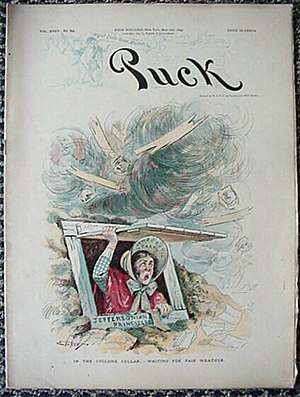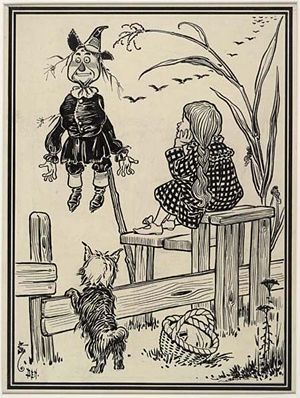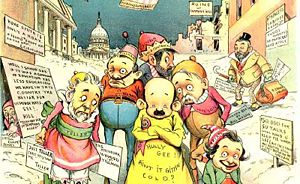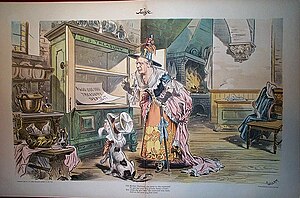Wizard of Oz: Difference between revisions
imported>Richard Jensen (links) |
imported>Richard Jensen No edit summary |
||
| Line 72: | Line 72: | ||
==Additional sources== | ==Additional sources== | ||
* The Tin Man was a common feature in political cartoons and in advertisements in the 1890s. Indeed, he had been part of European folk art for 300 years. | * The Tin Man was a common feature in political cartoons and in advertisements in the 1890s. Indeed, he had been part of European folk art for 300 years.<ref> Archie Green, ''Tin Men'' (2002) [http://www.amazon.com/Tin-Folklore-Society-Archie-Green/dp/0252073754/ref=sr_1_1?ie=UTF8&s=books&qid=1195302792&sr=8-1 excerpt and text search] covers the history of images of tin men in European and American illustrations for 300 years.</ref> | ||
[[Image:Tin3.JPG|right|thumb|200px|1899 soap ad shows Tin Man]] | [[Image:Tin3.JPG|right|thumb|200px|1899 soap ad shows Tin Man]] | ||
* The oil needed by the Tin Woodman had a political dimension at the time because Rockefeller's [[Standard Oil]] Company stood accused of being a monopoly (which was later ruled correct in a lawsuit brought by the federal government, and ultimately affirmed by the US Supreme Court.) In the 1902 stage adaptation the Tin Woodman wonders what he would do if he ran out of oil. "You wouldn't be as badly off as John D. Rockefeller," the Scarecrow responds, "He'd lose six thousand dollars a minute if that happened." | * The oil needed by the Tin Woodman had a political dimension at the time because Rockefeller's [[Standard Oil]] Company stood accused of being a monopoly (which was later ruled correct in a lawsuit brought by the federal government, and ultimately affirmed by the US Supreme Court.) In the 1902 stage adaptation the Tin Woodman wonders what he would do if he ran out of oil. "You wouldn't be as badly off as John D. Rockefeller," the Scarecrow responds, "He'd lose six thousand dollars a minute if that happened."<ref>Swartz, ''Oz'' p 34</ref> | ||
* The lion that Dorothy, Scarecrow and Tin-Man encounter in the enchanted forest may be a reference to [[William Jennings Bryan]], the Democratic candidate for president in 1896. Cartoons often portrayed leading politicians as lions, and Bryan was described as having a great roar with no bite. People asked in early 1900, when the book was written, if he had the courage to oppose the | * The lion that Dorothy, Scarecrow and Tin-Man encounter in the enchanted forest may be a reference to [[William Jennings Bryan]], the Democratic candidate for president in 1896. Cartoons often portrayed leading politicians as lions, and Bryan was described as having a great roar with no bite. People asked in early 1900, when the book was written, if he had the courage to oppose the McKinley Administration. | ||
* In 1900 by far the most famous farmer in America was [[Henry Cantwell Wallace]], editor of the leading farm magazine, ''Wallace's Farmer''. Everyone called him "Uncle Henry." | * In 1900 by far the most famous farmer in America was [[Henry Cantwell Wallace]], editor of the leading farm magazine, ''Wallace's Farmer''. Everyone called him "Uncle Henry."<ref> Henry Wallace and Richard S. Kirkendall. ''Uncle Henry: A Documentary Profile of the First Henry Wallace'' (1993) [http://www.amazon.com/Uncle-Henry-Documentary-Profile-Agricultural/dp/0813804248/ref=sr_1_3?ie=UTF8&s=books&qid=1195302873&sr=8-3 excerpt and text search] </ref> | ||
* "Aunt Em" is a matter of some dispute. Baum's mother-in-law was named [[Matilda Joslyn Gage]], and might be "Aunt M." She was a leader of the woman suffrage movement, but nothing about the book's character suggests suffrage interests. | * "Aunt Em" is a matter of some dispute. Baum's mother-in-law was named [[Matilda Joslyn Gage]], and might be "Aunt M." She was a leader of the woman suffrage movement, but nothing about the book's character suggests suffrage interests. | ||
| Line 145: | Line 145: | ||
--- | --- | ||
===Footnotes=== | |||
<references/> | <references/> | ||
Revision as of 06:36, 17 November 2007
The Wizard of Oz is the title character of the American children's novels by L. Frank Baum (1856-1919), of which the most famous is the first (with W.W. Denslow (1856-1915)[1] as illustrator), The Wonderful Wizard of Oz. The first book became a smash Broadway hit musical in 1903, and an unusually famous Hollywood movie of 1939. The books sold millions of copies, though the two coauthors wbecame alienated, and both went bankrupt. Baum recouped by moving to Hollywood and writing a new series of Oz books; the series was continued after his death in 1919
Political interpretations
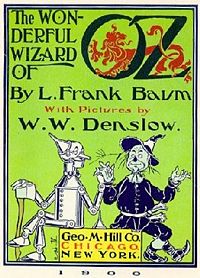
Many scholars have interpreted the 1900 book (as well as the 1902 Broadway play and 1939 movie) as an allegory of the political, economic and social events of America of the 1890s. Baum and Denslow did
Both Baum and Denslow had been actively involved in politics in the 1890s. Baum edited a Republican newspaper in South Dakota; Denslow was an editorial cartoonist for a major Chicago daily. Baum explained in his introduction:
- The old time fairy tale, having served for generations, may now be classed as "historical" in the children's library; for the time has come for a series of newer "wonder tales" in which the stereotyped genie, dwarf and fairy are eliminated, together with all the horrible and blood-curdling incidents devised by their authors to point a fearsome moral to each tale. Modern education includes morality; therefore the modern child seeks only entertainment in its wonder tales and gladly dispenses with all disagreeable incident. Having this thought in mind, the story of 'The Wonderful Wizard of Oz' was written solely to please children of today. It aspires to being a modernized fairy tale, in which the wonderment and joy are retained and the heartaches and nightmares are left out.[2](
The Broadway play was written for an adult audience, with many sexual innuendoes and a very sexy Dorothy.
Sources
The images and characters used by Baum and Denslow closely resembled political images that were well known in the 1890s. Baum and Denslow did not simply invent the Cowardly Lion, Tin Woodman, Scarecrow, gold-colored Yellow Brick Road, Silver Slippers, cyclone, monkeys, Emerald City, little people, Uncle Henry, witches and the wizard.
These were all common themes in the editorial cartoons of the previous decade. Baum and Denslow built a story around them, added Dorothy whose innocence and purity prove more powerful than the witches' magic. They added a series of lessons to the effect that everyone possesses the resources they need if only they had self-confidence. Positive thinking was a prevalent trend in this period, and Baum was involved with the Theososphy Movement (similar to Christian Science) that emphasized the power of pure thoughts over material evils. Bauum's point is that evil is in the mind, and it takes positive thinking, not a political revolution, to destroy it.
Baum in the 1890s edited the major national magazine for advertising in store windows, and was familiar with the elaborate mechanical displays of the Christmas story that attracted tens of thousands of spectators to the display windows of Marshall Field's, carson Pirie Scott, and other Chicago department stores.[3] The spellbinding mechanical ingenuity (based on intricate clockwork) led many viewers to believe there must be a man behind the screen who worked all the levers.
Political sources
Many of the events and characters of the book resemble the actual political personalities, events and ideas of the 1890s. The 1902 stage adaptation mentioned, by name, President Theodore Roosevelt, oil magnate John D. Rockefeller, Senator Mark Hanna and other political celebrities. (No real people are mentioned by name in the 1900 book.) Even the title has been interpreted as alluding to a political reality: oz. is an abbreviation for ounce, a unit familiar to those who fought for a 16 to 1 ounce ratio of silver to gold in the name of Bimetallism[4]
The book opens not in an imaginary place but in real life Kansas, which in the 1890s was well-known for the hardships of rural life, and for destructive tornadoes (also called cyclones). The Panic of 1893 caused widespread distress in rural America. Dorothy is swept away to a colorful land of unlimited resources that nevertheless has serious political problems. This utopia is ruled in part by wicked witches. Dorothy's cyclone is a political revolution that destroys the Wicked Witch of the East, slave-driver over the little people (Munchkins), who now celebrate their liberation. The Witch controlled the all-powerful silver slippers (which were changed to ruby in the 1939 film).
The Good Witch of the North (the northern electorate) tries to help Dorothy, but she is not very smart, does not realize the power of the slippers, and sends Dorothy down the very dangerous gold road. The national capital, the Emerald City, is a dream-like place based on the "White City," the common name for the Chicago World's fair of 1893, which Baum and Denslow attended often. The emarld green is an illusion (everyone must wear green glasses), symbolizing the fraudulent world of greenback paper money that only pretends to have value.
Other allegorical devices of the book include:
- Dorothy, naïve, young and simple, represents the American people. She is Everyman, led astray and who seeks the way back home. She resembles the young hero of Coin's financial school, a very popular political pamphlet of 1893. In her innocence and purity she is all powerful and personally kills two witches--she is Columbia, the symbol of the nation.
- The cyclone was used in the 1890s as a metaphor for a political revolution that would transform the drab country into a land of color and unlimited prosperity. The cyclone was used by editorial cartoonists of the 1890s to represent political upheaval.
- The Tin Woodman was a stock symbol in cartoons and advertisng. He was originally a human but was cursed by the Wicked Witch of the East so that every time he swung his axe he sliced off party of his body. As a good workman he replaced each part with tin, but now is all tin and has no heart. He is the worker dehumanized by industrialization, a common theme in Socialist literature of the day, such as expressed by Socialist candidate Eugene V. Debs in the 1900 election. The Woodman is rusted and helpless—ineffective until he starts to work together with the Scarecrow (the farmer), in a Farmer-Labor coalition that was much discussed in the 1890s, which culminated in the Farmer-Labor Party in Minnesota[5].
- The Munchkins are the little people—ordinary citizens. This 1897 Judge cartoon shows famous politicians as little people after they were on the losing side in the election.

Toto: Prohibitionist party (also called "Teetotalers")
Scarecrow: western farmers
Cowardly Lion: a cowardly politician, such as William Jennings Bryan
Wicked Witch of the East: Eastern factory owners and industrialists
Wicked Witch of the West: the trusts; one popular solution to the trust problem was to dissolve them, as Dorothy does
Flying Monkeys Pinkerton agents hired to break strikes
Wizard: President William McKinley
Oz: abbreviation for ounce of gold
Yellow Brick Road: gold standard
Cyclone: political revolution, the free silver movement
Emerald City: national capital
Silver Slippers: the free coinage of silver
Historian approach to the book
Among those historians and economists who support the approach that The Wizard of Oz is based on political symbolism of the 1890s the most widely accepted approach was published in 1964, when a high school history teacher named Henry Littlefield used the characters and events of The Wizard of Oz as metaphors to teach historical concepts. Together with his students, Littlefield drew parallels between historical events and events in the book, and eventually published these parallels in an article in the 1964 American Quarterly scholarly journal. Over the years, the idea captured the attention of many cartoonists, editorial writers, scholars, historians, economists, writers and journalists. Several writers expanded upon Littlefield's parallels, and soon the allegory was being analyzed in scholarly articles and textbooks in economics and history.
Editorial cartoonists in recent decades have made heavy use of Oz imagery in political cartoons; the first to do so was Rogers whose 1906 cartoon ridiculed mud-slinging publisher William Randolph Hearst as the Wizard of Ooze"
[[Image:Hearst06.jpg||thumb|300px|Cartoonist Rogers in 1906 sees the political uses of Oz: he depicts Hearst as Scarecrow stuck in his own Ooze in Harper's Weekly
U.S. monetary policy references
From 1880 to 1896, the price level in the U.S. economy fell by 23% [deflation). Farmers suffered because the prices they received for their produce declined while their debts grew. This fueled vigorous political debate between those who supported a move to a gold standard and supporters of the existing system of bimetalism - where the value of the dollar was tied to both gold and silver in a fixed ratio. Democratic presidential nominee William Jennings Bryan supported bimetalism, summarized in his Cross of Gold speech. However, Republican William McKinley won the presidency and the gold standard was introduced.
At the end of the story, Dorothy finds her way home, but it is not by just following the Yellow Brick Road. After her journey, Dorothy finds that the Wizard is incapable of helping her or her friends. In the end, she finds that the magical powers of her silver slippers help her. Since the silver slippers are the vote, she realizes that she had the power to fix the problems all along.
It should be noted, however, that the historian David Parker, in an article referenced in this article, cites evidence that Baum was in fact an 1896 McKinley supporter who opposed "silverism" as undermining business confidence and believed that the answer to America's economic problems lay in the Republican policy of "sound money" and protective tariffs.
Additional sources
- The Tin Man was a common feature in political cartoons and in advertisements in the 1890s. Indeed, he had been part of European folk art for 300 years.[6]
- The oil needed by the Tin Woodman had a political dimension at the time because Rockefeller's Standard Oil Company stood accused of being a monopoly (which was later ruled correct in a lawsuit brought by the federal government, and ultimately affirmed by the US Supreme Court.) In the 1902 stage adaptation the Tin Woodman wonders what he would do if he ran out of oil. "You wouldn't be as badly off as John D. Rockefeller," the Scarecrow responds, "He'd lose six thousand dollars a minute if that happened."[7]
- The lion that Dorothy, Scarecrow and Tin-Man encounter in the enchanted forest may be a reference to William Jennings Bryan, the Democratic candidate for president in 1896. Cartoons often portrayed leading politicians as lions, and Bryan was described as having a great roar with no bite. People asked in early 1900, when the book was written, if he had the courage to oppose the McKinley Administration.
- In 1900 by far the most famous farmer in America was Henry Cantwell Wallace, editor of the leading farm magazine, Wallace's Farmer. Everyone called him "Uncle Henry."[8]
- "Aunt Em" is a matter of some dispute. Baum's mother-in-law was named Matilda Joslyn Gage, and might be "Aunt M." She was a leader of the woman suffrage movement, but nothing about the book's character suggests suffrage interests.
- The poppies which surround the Emerald City are likely a reference to the opium poppies and the Boxer Rebellionin China of 1899.
[[Image:GC-LION.JPG|thumb|right|300px|1885 Puck shows President Cleveland as Lion, and shows other politicians as (flying?) monkeys.]]
- Politicians of the era often talked about wizards. For example, one senator debating the gold and silver issue in early 1900 said, “We all know of the performances of the world’s magicians, but it has remained for the Wizard of Missouri [Senator Cockrell] to wave his magic wand or his magic head and double the price of the silver of the world.”[9] Baum may have turned the Wizard of Missouri into the Wizard of Oz, who frightened people with his giant magic head.
- President McKinley was often called a "wizard" for his political skills. The Wizard of Oz seems to be the president of the Land of Oz. The "man behind the curtain" echoes the response to automated store window displays.
- Dogs were often used in political cartoons to represent politicians or parties. Perhaps "Toto" is a play on the word "teetotaler", and represents the Prohibitionists of the era, who were aligned with William Jennings Bryan in the 1896 and 1900 elections.
Stage and screen adaptations
The earliest musical version of the book was produced by Baum and Denslow in Chicago in 1902, and moved to Broadway in 1903, where it was a smash hit. It used the same characters, and was aimed more at adult audiences. It had a long, successful run on Broadway. Baum added numerous additional political references to the script. For example, his actors specifically mention President Theodore Roosevelt, Senator Mark Hanna, and John D. Rockefeller by name.[10]
The most famous adaptation is the 1939 film "The Wizard of Oz" featuring Judy Garland as Dorothy. Strong new political elements were added. The Wicked Witch of the West is shown as the same as the evil landowner in the opening scene who is trying to destroy Toto, while the Wizard is portrayed less as a humbug than as psychologically perceptive and helpful. The Wiz was a Broadway hit musical with an all-black cast emphasizing the liberation from slavery. It was later made into a 1978 movie directed by Sidney Lumet, and starring Diana Ross as Dorothy and Michael Jackson as the Scarecrow.
Bibliography
- Baum, L. Frank. The Wonderful Wizard of Oz (1900), online edition with black and white illustrations; online version from Gutenberg, without illustrations
- Clanton, Gene. Populism: The Humane Preference in America, 1890-1900 (1991)
- Culver, Stuart. "Growing Up in Oz." American Literary History 4 (1992) 607-28. in JSTOR
- Culver, Stuart. "What Manikins Want: The Wonderful Wizard of Oz and The Art of Decorating Dry Goods Windows and Interiors", Representations, 21 (1988) 97-116.
- Dighe, Ranjit S. ed. The Historian's Wizard of Oz: Reading L. Frank Baum's Classic as a Political and Monetary Allegory (2002) excerpt and text search
- Erisman, Fred. "L. Frank Baum and the Progressive Dilemma" in American Quarterly Vol. 20, No. 3 (Autumn, 1968), pp. 616-623. online at JSTOR
- Gardner, Todd. "Responses to Littlefield" (2004), online version
- Geer, John G. and Thomas R. Rochon, "William Jennings Bryan on the Yellow Brick Road," Journal of American Culture (Winter, 1993)
- Gilead, Sarah. "Magic Abjured: Closure in Children's Fantasy Fiction" in PMLA Vol. 106, No. 2 (Mar., 1991), pp. 277-293. in JSTOR
- Hearn, Michael Patrick (ed). The Annotated Wizard of Oz. (2000, 1973), highly detailed guide to the 1900 book; ignores all political issues.
- Jensen, Richard. The Winning of the Midwest: Social and Political Conflict, 1888-1896 (1971), ch. 10.
- Karp, Andrew. Utopian Tension in L. Frank Baum's Oz in Utopian Studies, 1998. online edition
- Kim, Helen M. "Strategic Credulity: Oz as Mass Cultural Parable" in Cultural Critique No. 33 (Spring, 1996), pp. 213-233. online at JSTOR
- Leach, William. Land of Desire: Merchants, Power, and the Rise of a New American Culture (1993), pp. 248-260. excerpt and text search
- Littlefield, Henry M. "The Wizard of Oz: Parable on Populism" American Quarterly Vol. 16, No. 1 (Spring, 1964), pp. 47-58; Littlefield was the first escolar to explore the allegories, though he mistakenly thought Baum supported Populismin JSTOR; another online version
- Nesbet, Anne. "In Borrowed Balloons: The Wizard of Oz and the History of Soviet Aviation" in The Slavic and East European Journal Vol. 45, No. 1 (Spring, 2001), pp. 80-95. online at JSTOR
- Parker, David. "The Rise and Fall of The Wonderful Wizard of Oz as a 'Parable on Populism'" The Journal of the Georgia Association of Historians, vol. 15 (1994), pp. 49-63 online edition
- Riley, Michael O. Oz and Beyond: The Fantasy World of L. Frank Baum. (1997) University of Kansas Press ISBN 0-7006-0832-X excerpt and text search
- Ritter, Gretchen. Goldbugs and Greenbacks: The Anti-Monopoly Tradition and the Politics of Finance in America (1997) excerpt and text search
- Ritter, Gretchen. "Silver slippers and a golden cap: L. Frank Baum's The Wonderful Wizard of Oz and historical memory in American politics." Journal of American Studies (August 1997) vol. 31, no. 2, 171-203.
- Rockoff, Hugh. "The 'Wizard of Oz' as a Monetary Allegory," Journal of Political Economy 98 (1990): 739-60, the source most often used by economists online at JSTOR
- Swartz, Mark Evan. Oz Before the Rainbow: L. Frank Baum's "The Wonderful Wizard of Oz" on Stage and Screen to 1939 (2000).
- Quentin P. Taylor, "Money and Politics in the Land of Oz," (Dec 2004) Independent
- Velde, Francois R. "Following the Yellow Brick Road: How the United States Adopted the Gold Standard" Economic Perspectives. Volume: 26. Issue: 2. 2002. online edition also online here
- Ziaukas, Tim. "100 Years of Oz: Baum's 'Wizard of Oz' as Gilded Age Public Relations" in Public Relations Quarterly, (Fall 1998) online version
External links
- full text of 6 Oz books by Baum
- A history of the debate
- Littlefield's 1992 article on the subject
- Collection of material relating to Oz as a political allegory
- Humbug: The Most Destructive Film in History by Paul Niquette
- The Fable of the Allegory: The Wizard of Oz in Economics, 2002 Review of the above and the academic context from the Journal of Economic Education.
- Oz as a spiritual allegory
- Why Oz is China: A Political Allegory
- Pros and cons of Oz as an allegory
- [3] copy of Hugh Rockoff, "The 'Wizard of Oz' as a Monetary Allegory," Journal of Political Economy 98 (1990): 739-60
- [4] David B. Parker, “The Rise and Fall of The Wonderful Wizard of Oz as a "Parable on Populism’” (1994)
---
Footnotes
- ↑ see Michael Patrick Hearn, "The Man Behind the Man Behind Oz: W. W. Denslow at 150," AIGA (July 05, 2006) at [1]
- ↑ from [[2]
- ↑ Culver (1988)
- ↑ Baum's son said he thought his father got the name from a file cabinet labeled A-N and O-Z.
- ↑ The party is now part of the Democratic-Farmer-Labor Party
- ↑ Archie Green, Tin Men (2002) excerpt and text search covers the history of images of tin men in European and American illustrations for 300 years.
- ↑ Swartz, Oz p 34
- ↑ Henry Wallace and Richard S. Kirkendall. Uncle Henry: A Documentary Profile of the First Henry Wallace (1993) excerpt and text search
- ↑ New York Times February 16, 1900 p 1
- ↑ Swartz, Before the Rainbow, pp 34, 47, 56
